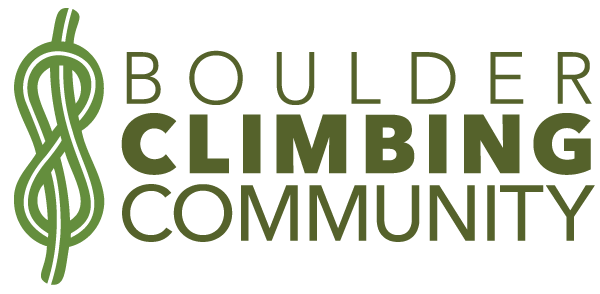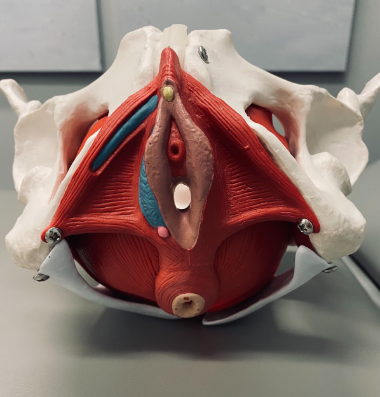Article by By Dr. Heather Fraebel of Mend Physical Therapy
“In the end, climbing was one of the only things my body felt good doing for the entirety of my pregnancy, and I climbed throughout, enjoying my final pregnant climbing session just 12 hours before going into labor.”
–Angie Payne
What is the Pelvic Floor?
The oft overlooked muscle group of the ‘core’, the pelvic floor muscles, which make up the bottom boundary of the ‘core’, play a huge role in providing the lumbopelvic stability needed to climb.
(while genitalia may differ, we all have the same musculature!)
As you can see, the pelvic floor is an intricate network of muscles attaching on the coccyx, sacrum, pubic bone, and hips that supports the bladder, uterus or prostate, and rectum and houses the sphincters controlling our urethra, anus, and vaginal canal or penile shaft. Unlike other muscles in the body, when something goes wrong with the pelvic floor, the symptoms aren’t as simple as a sore muscle. Rather, pelvic floor dysfunction can often present with a wide range of symptoms including: pain with sex, frequent urination, increased urinary urgency, frequent UTIs, pain with urination, urinary incontinence, vaginal burning, erectile dysfunction, constipation, pubic pain, hip pain, low back pain, etc etc.
How Do We Use Our Pelvic Floor While Climbing?
Pelvic floor muscle function is crucial to climbing performance and one wouldn't be able to generate proper core tension without it. The pelvic floor works in the system that is our ‘core’. No muscle works in isolation so when abdominal muscles, low back muscles, and hip muscles are activated, the pelvic floor muscles are also activated.
Think of the quick tightening that results if your foot slips when climbing: pelvic floor activating.
Think of the grip you get between your sitz bones with a heel hook: pelvic floor activating.
Think about the quick burst of tension on a dynamic move: pelvic floor activating.
Our pelvic floor provides essential stability while climbing which is what it is meant to do, but when those muscles either begin working over time or begin slacking off, dysfunction arises.
The two broad categories of climbers who need pelvic floor help:
Climbers with overactive pelvic floors
Pregnant or postpartum climbers
An Overactive Pelvic Floor
Through clinical experience, this is an unacknowledged and rampant issue in the climbing world. Time and time again a climber will present in clinic with symptoms of painful sex, erectile dysfunction, frequent and urgent urination, even incontinence (that’s right, peeing your pants or leaking is not always a weakness issue but can be an overuse issue), etc and upon exam we discover tight and hypertonic pelvic floor muscles that don’t know how to relax.
For a simple analogy, imagine walking around all day with your bicep clenched and your elbow bent. That muscle is not going to be happy going around tightened up all day long and is definitely not functioning in the way it is meant to. Just like the bicep, the pelvic floor is not happy when it is clenched all the time. Tension in these muscles translates to increased pressure on the bladder, increased irritation on pelvic floor nerves (that control urination and relay sensory information during sex), decreased muscular blood flow, and increased superficial nerve sensitivity (think burning sensations).
So what do we do with this in physical therapy?
To say this now to get it over with: NOT KEGELS. Kegels are rarely ever the answer for pelvic floor dysfunctions and especially not for overactive pelvic floor conditions, don’t let Google tell you otherwise!
Optimizing breathing to stretch and relax the pelvic floor muscles(see video below)
Education on how to relax those muscles when they should relax during activity (image below
Internal and external manual therapy techniques to release tension in pelvic floor muscles to teach your nervous system to stop clenching them
Before making the next move and while stationary, could you first inhale and feel your pelvic floor relax here? That would reset the muscle to allow it to have most strength potential during the move.
As many climbers ask me, no, decreasing tension in these muscles will not make them any weaker and will not decrease your core strength. If anything, releasing tension in these muscles will increase their strength and proper function. Think back to the bicep, a clenched and fatigued bicep is not going to have as much strength to provide.
“For many years I've suffered from pelvic pain that has effected my period, sex life and sometimes even everyday activities. I discovered through treatment that this was largely caused by holding stress in my pelvic floor muscles much like migraines can arise from stress held in neck muscles. Twenty years of climbing have made me good at creating and holding tension in my core, but I never consciously learned to release the tension again. To do so through pelvic PT has been a life changing experience.”
-Rannveig Aamodt
Pregnant and Postpartum Climbers
In a totally different category, pelvic health physical therapy treats pregnant and postpartum people who are concerned with how those states of life impact climbing. Can I climb while pregnant? Heck yes! (*the one caveat to mention is that bouldering is not recommended in ANY stage of pregnancy due to the risk of impact involved*) Top roping and to some extent lead climbing are fair game from week 1 to week 40 of pregnancy.
In consulting Google regarding activity during pregnancy, much fear based advice will pop up like avoiding core exercises, running, lifting…everything needed to keep a pregnant woman strong. Evidence supports that it is more dangerous to have women stop all exercise while pregnant than it ever would be to do a plank while pregnant.
Climbing could actually be very beneficial while pregnant to stay strong and also to help strengthen core muscles that actually help pop a baby out! In fact, many climbers actually feel stronger than ever returning postpartum when having climbed through pregnancy because it is essentially climbing with a 20-40lb weighted vest!
Tips for pregnant and postpartum climbers:
Watch for coning and try to correct it with using your transverse abdominis (see video below about how to engage your transverse abdominis)
Coning is a term to describe the visible midline abdominal bulge that can result during pregnancy or postpartum when there is a weakness at the linea alba and a separation of the rectus abdominal muscles.
2. Exhale on exertion: during exertion, there is an increase in pressure of the intraabdominal cavity and if the abdomen or pelvic floor are weak due to pregnancy or after child birth, those regions will be most susceptible to excess pressure and potential dysfunction like incontinence or diastasis recti. Exhaling during the biggest exertion while climbing (think a dyno, heel hook, etc.) can help eliminate that extra intra abdominal pressure.
Think EXHALE and engaging the transverse abdominis BEFORE making this move
3. See a pelvic physical therapist if you are leaking or have pain in at the low back, hips, pubic symphysis, etc. while climbing.
All pregnant and postpartum climbers should get the advice of a pelvic health physical therapist to get a comprehensive evaluation to understand their individual needs.
“As someone who is normally quite active, I had no idea how pregnancy would affect my life. When I learned that I was pregnant I immediately became worried about how hard to push my body. I was scared to engage my core at all, and wasn’t sure how much climbing I would be able to do. Seeing Heather was a game-changer for my pregnancy, as she encouraged me to remain active and to keep climbing and helped me gauge what my body (and specifically my core) was still capable of through the various stages of pregnancy. The exercises and knowledge she shared were pivotal in keeping me and my pelvic floor as healthy as possible while remaining active for all 39.5 weeks. In the end, climbing was one of the only things my body felt good doing for the entirety of my pregnancy, and I climbed throughout, enjoying my final pregnant climbing session just 12 hours before going into labor.”
–Angie Payne
If you are interested in learning more about how the pelvic floor comes into play with climbing and how physical therapy could help you with pelvic floor dysfunction, please contact Dr. Heather Fraebel at Mend Physical Therapy in Boulder at heather@mendcolorado.com . Mend is a physical therapy and sports medicine clinic that treats all body regions and people of all athletic abilities, with a specialty in pelvic health.
Mend is committed to the health of climbers and our climbing areas and shares the vision of the Boulder Climbing Community. BCC members get their first appointment free and their second appointment 25% off!
Looking for more evidence-based content specifically regarding pelvic health? Visit the Mend pelvic health blog and the physical therapy for female pelvic health or male pelvic health home page.






